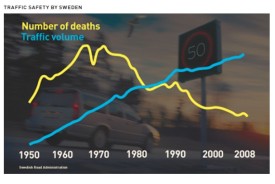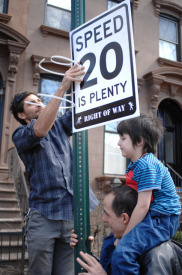When you ask people to estimate how many people are killed on American roads each year, the answers vary widely: 1 million? 500,000? 40,000? 2,000?
As the video below shows, when you ask them what Washington state’s traffic death goal should be, most people have no idea. They offer tentative guesses, ranging from fewer than 100 to 5,000. (For context, there are actually about 33,000 annual US traffic deaths now, and 437 people lost their lives on Washington roads in 2013.)
But watch the video until minute 2:22, when the interviewers ask people what the traffic death goal for their family should be. Everyone knows immediately: Zero. Zero. Zero. None. Absolutely zero. Zero, of course. I would want zero. (Except for the funny guy: “A couple of them I’d like to run over if that would help your numbers any.”)
When the same people are asked again what the state’s traffic death goal should be, everyone smiles. Now they have an answer they believe in: Zero. That should be the goal for everyone.
That’s the driving principle behind Vision Zero, a movement that started in Sweden in 1997. More recently, it’s spread to US cities like New York, Chicago, San Francisco, and even Los Angeles. Both Portland and Seattle plan to roll out local Vision Zero plans too. So it’s worth examining what Vision Zero is—and what it is not.
What is Vision Zero?
Vision Zero is an approach to traffic management that starts with the idea that everyone has the right to be safe in traffic. It’s rooted in the belief that every traffic death and injury reflects a failure in the system, and that none are acceptable. That’s how many people feel about airplane crashes or medical mistakes or homicides, yet fatal traffic crashes are tolerated as inevitable.
That’s because we’ve designed most of our streets to move cars and trucks around, usually as quickly and efficiently as possible. And we’ve essentially accepted that killing some number of six-year-olds, or cyclists, or elderly pedestrians is the price we have to pay for that.
The Vision Zero philosophy says that keeping people alive and healthy ought to be the number one priority in how we design city roadways, outranking concerns about vehicle speeds and convenience and other objectives. (This CityLab Q and A with Sweden’s top traffic safety strategist offers a great introduction.)
Vision Zero’s approach also differs from traffic safety campaigns that attempt to change individuals’ behaviors behind the wheel. These may distribute neon cut-outs of children telling drivers to slow down or advertise “click it or ticket” billboard campaigns or appeal to people’s moral sense that they ought to look out for other people.
In the city of Seattle’s recent “Be Super Safe” campaign, for instance, “creating a culture of empathy” for other road users was a key goal (among others.) But the outreach campaign primarily focused on getting individuals to do things differently, telling drivers they could be “safety superheroes” by following simple steps like turning off phones, planning enough time to get where we’re going, knowing the speed limit, etc.
By contrast, Vision Zero puts the onus on local governments to create safe streets where even drivers who fail to pay attention (as everyone does from time to time) or aren’t at all empathetic are relatively harmless. Essentially, traffic systems must be designed to account for human error and to protect people who walk, bike, and drive from the mistakes we can count on people making.
This isn’t a new idea. We design airplane cockpits and nuclear reactor controls and operating room procedures so that even if someone makes a mistake, there’s enough redundant protection built into the system that no one gets hurt.
That’s why Vision Zero uses engineering, safer roadway design, and automated technology—from in-vehicle breathlyzers to cameras that enforce speed limits—as well as traditional education and outreach campaigns.
What does that look like, exactly?

Sweden, which pioneered Vision Zero, is aiming to cut traffic deaths in half by 2020 and to eliminate them by 2050. These goals were revised after failing to meet more ambitious targets, but the country has made progress. When Sweden launched Vision Zero in 1997, it recorded between six and seven traffic fatalities per 100,000 people. Today, despite increased traffic volumes, that number has been cut in half to three. (In the US, it’s nearly 11.)
So what did they do? For starters, their Vision Zero principles say that people who walk and bike shouldn’t mix freely with traffic traveling more than 30 kph (about 18 mph.) People in cars shouldn’t be exposed to other vehicles traveling faster than 50 kph (30 mph) in intersections where side crashes are possible or to oncoming traffic that exceeds 70 kph (43 mph). Beyond that, you need infrastructure to separate users or prevent crashes.
Toward that end, Sweden has lowered speed limits, designed streets to physically slow cars, and separated different road users. In some locations, that has meant calming traffic with speed humps, narrower roadways, and landscaping planters. In others, it’s building separated walking and biking paths, investing in pedestrian bridges, putting streets on “road diets,” outlawing right turns on red, erecting barriers to separate two-way traffic, or replacing traffic lights with roundabouts that force drivers to slow down and pay closer attention at intersections. (With roundabouts, for instance, Sweden accepts that the number of minor crashes may go up a bit. But it’s looking for better outcomes—with fewer deaths and serious injuries—because the cars aren’t traveling that fast.)
The country has also benefited from technological improvements—from airbags to alcohol locks that prevent a drunk driver from starting a car—as well as automated enforcement tools. It uses a data-driven approach to pinpoint unsafe locations and relies on a network of more than 1000 fixed speed cameras to catch speeding drivers.

More recently, New York City Mayor Bill de Blasio launched the city’s own Vision Zero initiative in 2014, with the goal of eliminating all traffic deaths and serious injuries within a decade. The city’s plan relies on an integrated suite of engineering improvements, lower speed limits, more consistent enforcement, outreach campaigns, and tougher penalties for offending drivers. In the initiative’s first year, New York recorded the fewest number of pedestrian deaths since record keeping began in 1910.
De Blasio took the bold step of reducing speed limits citywide from 30 mph to 25 mph, over the objection of drivers, cabbies, and impatient New Yorkers. But the PBS NewsHour interview below with a mom whose nine-year-old son was killed by a taxi while crossing the street (with a green light and holding his dad’s hand) begins to explain why the city did it.
New York has also created “neighborhood slow zones” with lower 20 mph limits, which have signage and other traffic calming tools to make that network of streets safer and more family-friendly. They’re so popular that Brooklyn residents who want the city to expand the program have installed guerilla “20 is plenty” street signs to look like official speed limit signs.
The city also promised to engineer safety improvements at 50 dangerous intersections/corridors each year, enhance street lighting at 1000 intersections, create more arterial and neighborhood slow zones, install 20 new speed cameras and get state permission for more, increase enforcement efforts, enact stiffer penalties for violators, and make traffic safety data more interactive and transparent.
The city council has passed 15 bills around traffic safety, and the New York Police Department issued 42 percent more speeding tickets in 2014 and 126 percent more summonses to drivers who fail to yield to people walking.
Closer to home, Washington State in 2000 became one of the first states in the country to adopt a goal of zero traffic fatalities and serious injuries by 2030. Among other things, the state has focused on strengthening DUI laws, better enforcement of impaired driving, engineering improvements to keep people from running off the road, and anti-texting and cell use laws. Since 2002, the number of fatal traffic crashes in Washington state has fallen roughly 25 percent faster than the country as a whole.
What isn’t Vision Zero?
It turns out that Seattle already has a stated goal of zero fatalities from traffic crashes, and it has begun re-engineering some streets to make them safer. This year it plans to embrace some of the other ideas, like neighborhood 20 mph slow zones, that other cities have pioneered. But it’s important to remember that truly embracing Vision Zero isn’t just about setting a number or lowering speed limits.
Vision Zero requires a wholesale paradigm shift that elevates human life above speed and convenience. It also requires actual money to make it happen—whether the investments come in the form of better street design or safer intersections or tougher enforcement. As Sweden’s Traffic Safety Strategist Matts-Åke Belin explained to CityLab:
Clearly we have seen it is not enough to, for example, change the speed limit. You maybe have to put in speed bumps. You have to think through all the conflict spots that you have in your traffic system. And do things about it.
And Vision Zero isn’t just about safety, as Belin also points out. It’s about creating a livable city that works for people—where kids can walk to school safely and moms feel comfortable riding bikes to work and seniors have enough time to cross the street—as well as cars. As Belin said:
When you get this red hand, and they start counting down, and it’s very short of time, it’s not friendly from a human perspective. But to go from there to blame the users of cars, we don’t want to do that either. Because we want something good for them also. So it’s not a war between unprotected road user and protected road user. Here we need to have a more holistic perspective.


Comments are closed.